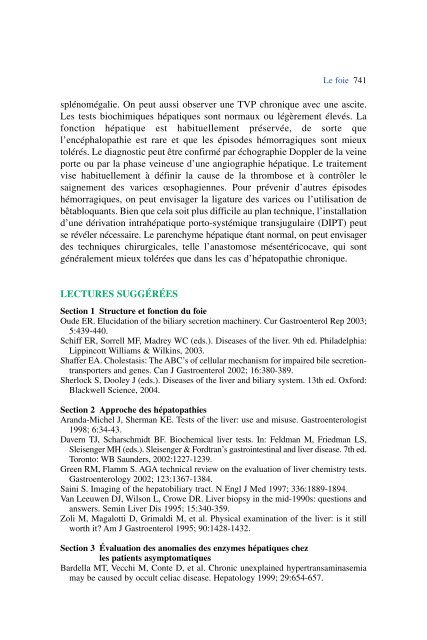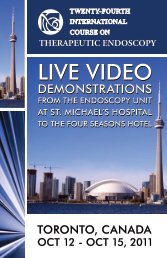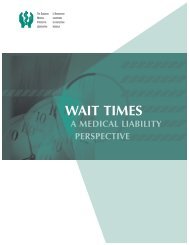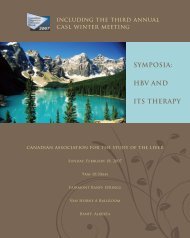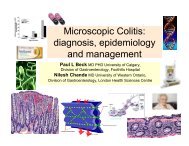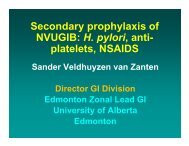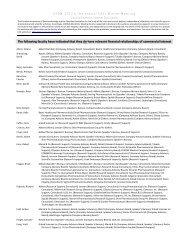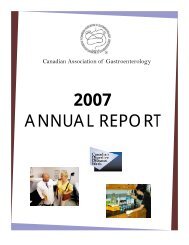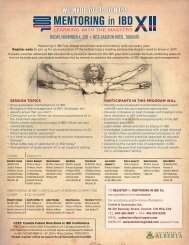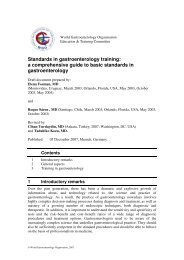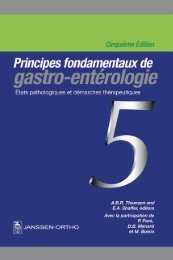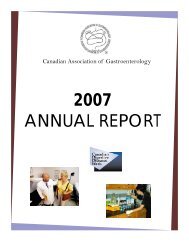Untitled - The Canadian Association of Gastroenterology
Untitled - The Canadian Association of Gastroenterology
Untitled - The Canadian Association of Gastroenterology
You also want an ePaper? Increase the reach of your titles
YUMPU automatically turns print PDFs into web optimized ePapers that Google loves.
Le foie 741<br />
splénomégalie. On peut aussi observer une TVP chronique avec une ascite.<br />
Les tests biochimiques hépatiques sont normaux ou légèrement élevés. La<br />
fonction hépatique est habituellement préservée, de sorte que<br />
l’encéphalopathie est rare et que les épisodes hémorragiques sont mieux<br />
tolérés. Le diagnostic peut être confirmé par échographie Doppler de la veine<br />
porte ou par la phase veineuse d’une angiographie hépatique. Le traitement<br />
vise habituellement à définir la cause de la thrombose et à contrôler le<br />
saignement des varices œsophagiennes. Pour prévenir d’autres épisodes<br />
hémorragiques, on peut envisager la ligature des varices ou l’utilisation de<br />
bêtabloquants. Bien que cela soit plus difficile au plan technique, l’installation<br />
d’une dérivation intrahépatique porto-systémique transjugulaire (DIPT) peut<br />
se révéler nécessaire. Le parenchyme hépatique étant normal, on peut envisager<br />
des techniques chirurgicales, telle l’anastomose mésentéricocave, qui sont<br />
généralement mieux tolérées que dans les cas d’hépatopathie chronique.<br />
LECTURES SUGGÉRÉES<br />
Section 1 Structure et fonction du foie<br />
Oude ER. Elucidation <strong>of</strong> the biliary secretion machinery. Cur Gastroenterol Rep 2003;<br />
5:439-440.<br />
Schiff ER, Sorrell MF, Madrey WC (eds.). Diseases <strong>of</strong> the liver. 9th ed. Philadelphia:<br />
Lippincott Williams & Wilkins, 2003.<br />
Shaffer EA. Cholestasis: <strong>The</strong> ABC’s <strong>of</strong> cellular mechanism for impaired bile secretiontransporters<br />
and genes. Can J Gastroenterol 2002; 16:380-389.<br />
Sherlock S, Dooley J (eds.). Diseases <strong>of</strong> the liver and biliary system. 13th ed. Oxford:<br />
Blackwell Science, 2004.<br />
Section 2 Approche des hépatopathies<br />
Aranda-Michel J, Sherman KE. Tests <strong>of</strong> the liver: use and misuse. Gastroenterologist<br />
1998; 6:34-43.<br />
Davern TJ, Scharschmidt BF. Biochemical liver tests. In: Feldman M, Friedman LS,<br />
Sleisenger MH (eds.). Sleisenger & Fordtran’s gastrointestinal and liver disease. 7th ed.<br />
Toronto: WB Saunders, 2002:1227-1239.<br />
Green RM, Flamm S. AGA technical review on the evaluation <strong>of</strong> liver chemistry tests.<br />
<strong>Gastroenterology</strong> 2002; 123:1367-1384.<br />
Saini S. Imaging <strong>of</strong> the hepatobiliary tract. N Engl J Med 1997; 336:1889-1894.<br />
Van Leeuwen DJ, Wilson L, Crowe DR. Liver biopsy in the mid-1990s: questions and<br />
answers. Semin Liver Dis 1995; 15:340-359.<br />
Zoli M, Magalotti D, Grimaldi M, et al. Physical examination <strong>of</strong> the liver: is it still<br />
worth it? Am J Gastroenterol 1995; 90:1428-1432.<br />
Section 3 Évaluation des anomalies des enzymes hépatiques chez<br />
les patients asymptomatiques<br />
Bardella MT, Vecchi M, Conte D, et al. Chronic unexplained hypertransaminasemia<br />
may be caused by occult celiac disease. Hepatology 1999; 29:654-657.


